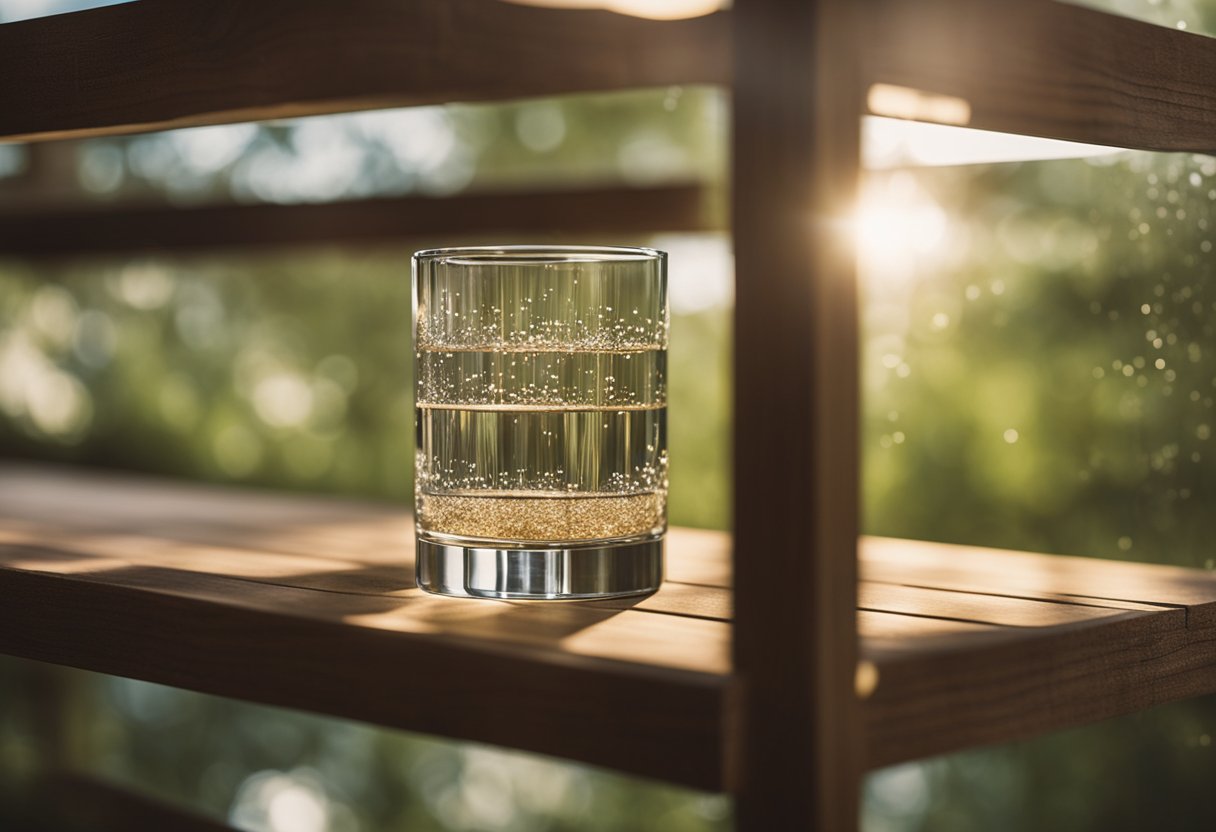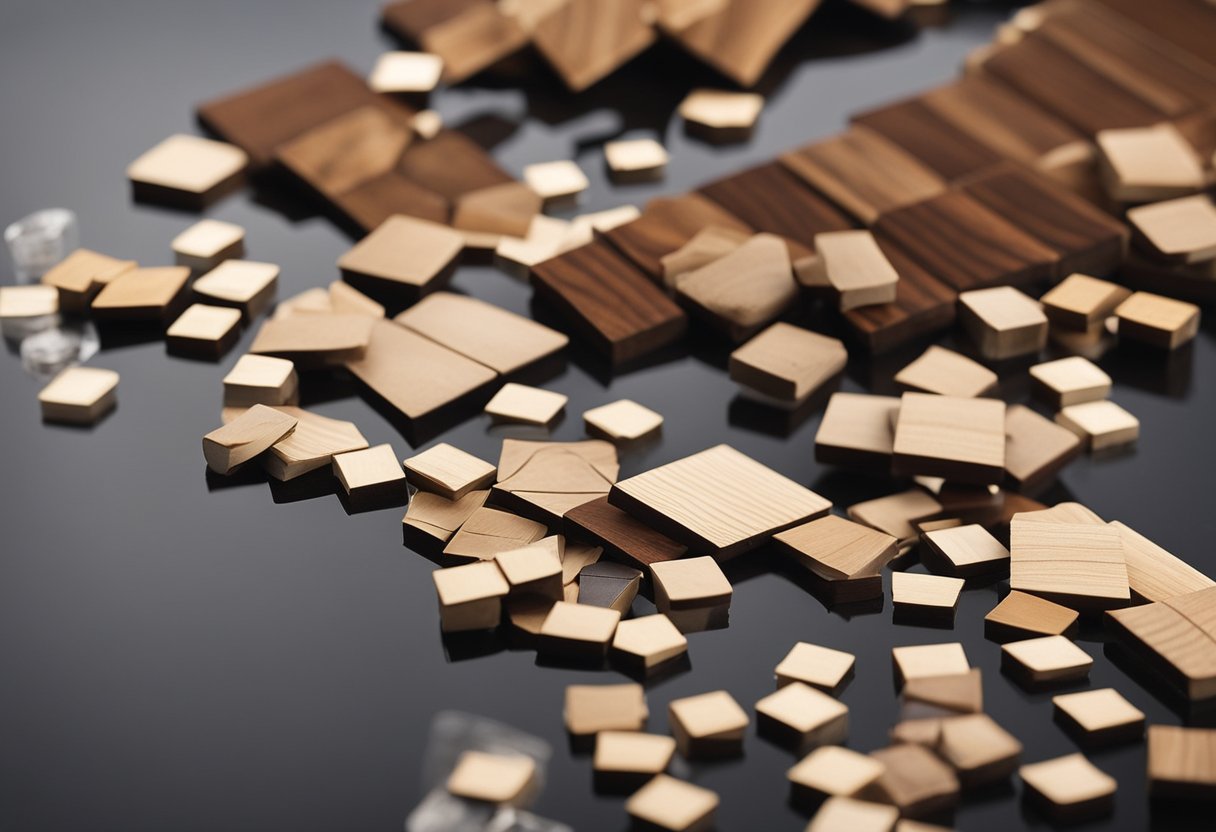Gluing wood to glass can be a tricky task, but with the right adhesive and preparation, it can be done successfully. Whether you’re working on a DIY project or repairing a broken item, knowing how to glue wood to glass is a skill that can come in handy. In this article, I will guide you through the process of gluing wood to glass and provide you with some helpful tips.
Understanding the materials is the first step in gluing wood to glass. Glass is a non-porous material, which means it doesn’t absorb adhesives easily. Wood, on the other hand, is porous and can absorb adhesives if not properly sealed. Choosing the right adhesive is crucial to ensure a successful bond. There are different types of adhesives available, such as epoxy, cyanoacrylate, polyurethane, and silicone, each with its own strengths and weaknesses.
Key Takeaways
- Understanding the materials is crucial in gluing wood to glass.
- Choosing the right adhesive is important for a successful bond.
- Proper preparation and application of the adhesive are key to a strong and lasting bond.
Understanding the Materials
https://www.youtube.com/watch?v=tE2lVjB3Cvs&embed=true
When it comes to gluing wood to glass, it’s important to understand the nature of both materials. Wood is a porous material that can absorb moisture, while glass is smooth and non-porous. This means that it can be a bit challenging for adhesives to create a strong bond between the two materials.
Temperature and humidity can also play a significant role in the success of your glue job. For example, if the temperature is too low, the glue may not cure properly, and if the humidity is too high, the glue may take longer to dry. Therefore, it’s essential to choose the right adhesive for your specific project and to follow the manufacturer’s instructions carefully.
There are several types of adhesives that can be used to glue wood to glass, including cyanoacrylates, polyurethane glues, silicone adhesives, two-part epoxies, and hot glue from a glue gun. Each type of adhesive has its own unique properties and benefits, so it’s important to choose the right one for your specific project.
In general, epoxy adhesive is considered the best glue to use to attach glass to wood thanks to its durable and powerful bonding qualities. Epoxy can be used on a wide range of surfaces, dries clear, and forms a seriously strong bond. Other popular options include superglue (a convenient choice), silicone glue, or even hot glue from a glue gun.
It’s important to note that not all adhesives are created equal, and some may be more suitable for certain types of wood or glass than others. Therefore, it’s important to do your research and choose the right adhesive for your specific project.
Choosing the Right Adhesive
https://www.youtube.com/watch?v=TLHcNla6m6w&embed=true
When it comes to glueing wood to glass, choosing the right adhesive is crucial to ensure a strong and long-lasting bond. There are several factors to consider when selecting an adhesive, such as the type of wood and glass, the size of the surface area, and the intended use of the finished product.
Some of the most popular adhesives for wood to glass bonding include epoxy, cyanoacrylate (super glue), clear silicone, and polyurethane glue. Each of these adhesives has its own unique properties and suitability for different types of wood and glass.
Epoxy is a two-component adhesive that is known for its high strength and durability. It works well with various types of wood and glass and is waterproof once cured. Cyanoacrylate glue, also known as super glue, is a fast-drying adhesive that is ideal for small projects. It works well with non-porous surfaces and is not recommended for use with large surface areas.
Clear silicone is another popular adhesive for wood to glass bonding. It is easy to apply and dries clear, making it ideal for projects where appearance is important. Polyurethane glue is a versatile adhesive that works well with a variety of surfaces, including wood and glass. It is waterproof and dries to a tough, durable finish.
When choosing an adhesive, it is essential to consider the surface textures of the wood and glass. Some adhesives work better with rougher surfaces, while others are better suited for smoother surfaces. It is also important to consider the curing time and the clamping requirements of the adhesive.
Overall, epoxy resin, cyanoacrylate, and clear silicone are the most suitable adhesives for wood to glass bonding. However, it is important to choose the right adhesive based on the specific needs of your project.
Preparation Process
https://www.youtube.com/watch?v=7ctA4DzLHcA&embed=true
Before gluing wood to glass, it is important to take the necessary steps to ensure a strong and long-lasting bond. Here are some preparation steps that I follow:
Clean the Glass and Wood Surfaces
I always clean the glass and wood surfaces thoroughly before starting the gluing process. For glass, I use a glass cleaner to remove any dirt, dust, or fingerprints. After that, I wipe it down with a clean and dry cloth to ensure that there is no moisture left on the surface. For wood, I use a degreaser to remove any oil or grease on the surface. Then, I sand the surface to create a smooth surface for better adhesion.
Choose the Right Glue
Choosing the right glue is important for the success of the bonding process. For wood-to-glass bonding, I use epoxy adhesive as it possesses impressive strength and can be applied to a wide range of surfaces. Polyurethane glue is also a good option as it fills gaps between uneven surfaces, making it ideal for tricky wood-to-glass connections.
Apply the Glue
After choosing the right glue, I apply it to one of the surfaces. I use a brush or a spreader to spread the glue evenly on the surface. Then, I press the two surfaces together and hold them in place for about 30 seconds or as directed on the glue label.
Let it Dry
After bonding the two surfaces together, I let the bond dry for a day or so before using them. This gives the glue enough time to harden and create a strong bond between the wood and glass surfaces.
By following these preparation steps, I ensure that the wood-to-glass bond is strong and long-lasting.
Application of the Adhesive
https://www.youtube.com/watch?v=4ElbQ18bkXU&embed=true
When it comes to gluing wood to glass, the application of the adhesive is crucial. There are a few ways to apply the adhesive, and choosing the right method can make all the difference in the strength and durability of the bond.
One popular method is to use a caulking gun to apply the adhesive. This allows for a precise and even application of the glue. It is important to use a high-quality adhesive that is specifically designed for bonding wood to glass. I recommend using a polyurethane glue or an epoxy adhesive. These types of adhesives are strong, durable, and can withstand exposure to moisture and heat.
Another method is to use double-sided tape. This is a quick and easy way to attach lightweight pieces of wood to glass. However, it is not recommended for larger or heavier pieces as the bond may not be strong enough.
Regardless of the method you choose, it is important to protect your hands with protective gloves. Adhesives can be messy and difficult to remove from skin, so wearing gloves can prevent any accidental skin contact.
When applying the adhesive, be sure to follow the manufacturer’s instructions carefully. Apply the adhesive evenly and avoid using too much, as this can cause the bond to weaken over time. Allow the adhesive to dry completely before handling the bonded materials.
In summary, the application of the adhesive is a critical step in bonding wood to glass. Using the right adhesive and application method can ensure a strong and durable bond. Remember to protect your hands with gloves and follow the manufacturer’s instructions carefully.
Bonding and Drying
https://www.youtube.com/watch?v=KWmwbF517Jc&embed=true
When it comes to bonding wood to glass, it is important to choose the right adhesive to ensure a strong and lasting bond. One of the most popular adhesives for this purpose is epoxy resin adhesive. It is a two-part adhesive made up of a resin and hardener that is mixed together before application. Epoxy is known for its strength and durability, making it an ideal choice for bonding glass and wood.
The bond strength of epoxy adhesive is influenced by several factors, including the surface preparation of the wood and glass, the amount of adhesive applied, and the curing time. It is important to ensure that both surfaces to be bonded are clean, dry, and free of any dust or debris. This will help to ensure a strong bond and prevent any stress on the bond.
The drying time of epoxy adhesive can vary depending on the specific product and the temperature and humidity of the environment. In general, epoxy adhesive will dry to the touch within a few hours, but it may take up to 24 hours or more to fully cure. It is important to allow the adhesive to fully cure before applying any stress to the bond.
In addition to epoxy adhesive, other popular options for bonding wood to glass include superglue, silicone glue, and hot glue from a glue gun. Each of these adhesives has its own unique properties and strengths, so it is important to choose the right adhesive for your specific project.
Overall, bonding wood to glass can be a challenging task, but with the right adhesive and proper surface preparation, a strong and lasting bond can be achieved.
Post Application Measures
After applying the glue, it is important to take some measures to ensure that the bond between the wood and glass is strong and long-lasting. Here are some post-application measures that I recommend:
1. Allow Sufficient Time for Drying
After applying the glue, give it enough time to dry completely. The drying time may vary depending on the type of glue used. Generally, it is recommended to leave the glued wood and glass surfaces undisturbed for at least 24 hours. During this time, avoid touching or moving the glued surfaces to prevent any damage to the bond.
2. Check for Water Resistance
If you plan to use the wood and glass item outdoors or in a damp environment, it is important to ensure that the bond is waterproof. Check the label of the glue to see if it is waterproof or not. If the glue is not waterproof, you can apply a waterproofing agent to the bond.
3. Avoid Rust
If you used metal clamps to hold the wood and glass surfaces together while the glue dried, make sure to remove them as soon as the glue is dry. Metal clamps can cause rust stains on the wood or glass surfaces if left in contact with them for a long time.
4. Clean Up Excess Glue
If any excess glue has spilled onto the wood or glass surfaces, it is important to clean it up before it dries. Use a damp cloth to wipe away any excess glue. If the glue has already dried, you can use a scraper or sandpaper to remove it.
By following these post-application measures, you can ensure that the bond between the wood and glass surfaces is strong, waterproof, and long-lasting.
Safety Precautions
When working with glue, particularly when gluing glass to wood, safety should be your top priority. Here are some safety precautions to follow:
- Wear Gloves: Before starting the gluing process, put on gloves to protect your hands from the glue. Latex or nitrile gloves are ideal as they provide a good grip and protect your skin from the chemicals in the glue.
- Use a Razor Blade: If you need to remove any excess glue from the surface, use a razor blade. Be careful not to cut yourself or scratch the surface of the glass or wood.
- Work in a Well-Ventilated Area: The fumes from the glue can be harmful if inhaled, so make sure you work in a well-ventilated area. If possible, open a window or use a fan to help circulate the air.
- Use a Hair Dryer: If you need to speed up the drying process, use a hair dryer on a low heat setting. Hold the hair dryer a few inches away from the surface and move it back and forth to evenly distribute the heat.
By following these safety precautions, you can ensure that your gluing process goes smoothly and safely. Remember to always read the label and follow the instructions provided by the manufacturer.
Potential Challenges and Solutions
When gluing wood to glass, there are a few potential challenges that one might face. Here are some of the most common ones and their solutions:
Gaps
One of the biggest challenges when gluing wood to glass is dealing with gaps between the two surfaces. This can be especially problematic if the wood is not perfectly flat or if the glass is curved. In such cases, it can be difficult to achieve a strong and lasting bond.
To overcome this challenge, I recommend using a polyurethane glue. This type of glue is flexible and can fill gaps between uneven surfaces, making it ideal for tricky wood-to-glass connections. Another option is to use a specialized glass adhesive, which can achieve exceptional strength while maintaining transparency.
Chemical Resistance
Another challenge when gluing wood to glass is ensuring that the bond is resistant to chemicals and other harsh substances. This is especially important if the finished product will be used in a laboratory or industrial setting.
To ensure chemical resistance, I recommend using an epoxy resin. This type of glue is highly resistant to chemicals and can create a strong and lasting bond between wood and glass.
Rigid Bond
Finally, it is important to ensure that the bond between the wood and glass is rigid enough to withstand any stress or strain that might be placed on it. This is especially important if the finished product will be used in a high-stress environment or if it will be subjected to frequent use.
To achieve a rigid bond, I recommend using a silicone adhesive. This type of glue can both seal gaps and work like glue to bond wood to glass, and some of them are great for outdoor use. Silicone adhesive is gooey and a bit like toothpaste, and it squirts out a bit from between the bonded areas if too much is applied.
Additional Uses of Adhesives
As a glue expert, I have found that adhesives have a wide range of uses beyond just bonding wood to glass. Here are a few additional applications where adhesives can be used effectively:
Tile and Cement
Adhesives can be used to bond tiles to floors or walls. Epoxy, silicone, and polyurethane adhesives are popular choices for this application. These adhesives offer excellent water resistance and can withstand high temperatures.
Plastic and Vinyl
Adhesives can be used to bond plastic and vinyl materials. Cyanoacrylate and epoxy adhesives work well for this application. They offer excellent bonding strength and can withstand exposure to water and heat.
Leather and Fabric
Adhesives can be used to bond leather and fabric materials. Contact cement and hot melt adhesives are popular choices for this application. They offer excellent bonding strength and can withstand exposure to water and heat.
Steel and Grip
Adhesives can be used to bond steel and other metals. Epoxy and polyurethane adhesives work well for this application. They offer excellent bonding strength and can withstand exposure to water and heat.
Cardboard and Porcelain
Adhesives can be used to bond cardboard and porcelain materials. Cyanoacrylate and epoxy adhesives work well for this application. They offer excellent bonding strength and can withstand exposure to water and heat.
Sculpture
Adhesives can be used in sculpture to bond various materials together. Epoxy, silicone, and polyurethane adhesives are popular choices for this application. They offer excellent bonding strength and can withstand exposure to water and heat.
In addition to the above applications, adhesives can also be used for bonding PVC, primer, and other materials. It is important to choose the right adhesive for the job to ensure a strong and long-lasting bond.
Frequently Asked Questions
What type of glue is best for attaching glass to wood?
There are several types of glue that can be used to attach glass to wood, but the best one is silicone adhesive. Silicone adhesive is a waterproof, heat-resistant, and flexible adhesive that is perfect for bonding glass and wood together. It also provides a strong and durable bond that can withstand stress and strain.
Can Gorilla Glue be used to attach glass to wood?
Gorilla Glue is a popular adhesive that can be used for a variety of projects, but it is not recommended for attaching glass to wood. Gorilla Glue expands as it dries, which can cause the glass to crack or break. It is also not waterproof, which can cause the bond to weaken over time.
Is super glue effective for bonding glass to wood?
Super glue is not recommended for bonding glass to wood, as it is not strong enough to hold the weight of the glass. It is also not flexible, which can cause the bond to break if the glass is subjected to stress or strain.
Will silicone adhesive hold wood and glass together?
Yes, silicone adhesive is the best adhesive for bonding wood and glass together. It provides a strong and durable bond that can withstand stress and strain, and it is also waterproof and heat-resistant.
Which transparent glue is recommended for bonding glass and wood?
There are several transparent glues that can be used for bonding glass and wood, but the best one is clear epoxy. Clear epoxy is a two-part adhesive that provides a strong and durable bond, and it dries clear, making it perfect for projects where the bond will be visible.
How can I securely attach glass to a wooden table top?
To securely attach glass to a wooden table top, you should use silicone adhesive. First, clean both the glass and the wood surface thoroughly with rubbing alcohol. Apply a thin layer of silicone adhesive to the wood surface, and then carefully place the glass on top of the adhesive. Press down firmly on the glass to ensure a strong bond, and then let the adhesive dry completely before using the table.

Hi, I’m Sal Muller of Tooltrip.com. My DIY experience led me to understand essential power tools for home projects. Tooltrip.com guides enthusiasts and professionals in choosing right tools for any job. I provide concise top tool reviews for easier, efficient DIY.







